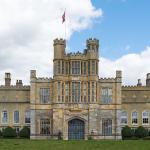Coughton Court, Warwickshire
Coughton Court near Alcester in Warwickshire is a National Trust-owned Tudor manor house built on land that has been home to the Throckmorton family for over 600 years. A fine building, but not all accessible, it sits in an estate of managed gardens, orchards, parks, and woodlands.
As with all houses this age, it has numerous stories to tell of love, scandalAn event or action that causes public outrage, or the outrage caused by that event or action.An event or action that causes public outrage, or the outrage caused by that event or action. , and intrigue. But uncommon to most, it also claims a place in one of most well-known stories of England: the Gunpowder Plot. A devoted Catholic, Sir George Throckmorton, once a favourite of Henry VIII, fell from his king’s favour over the Great Matter and the English Reformation. Continuing to practice CatholicismThe faith and practices of the Roman Catholic Church., the family suffered huge recusancy fines, limiting further building work, and risked much to further the Catholic cause. Francis Throckmorton was discovered in 1583 in a plot to assassinate Elizabeth I and replace her, with Spanish help, with her Catholic cousin, Mary Queen of Scots. Confessing under torture, he was executed for treason in 1584. But the family’s protest against the persecution of Catholics didn’t end there. Catholic priests continued to visit the house to deliver the now-illegal Mass, and the famous Nicholas Owen, or ‘Little John’, was commissioned to build a priest hole, which was fully opened in 1910. In 1605, the Catholic-convert and Gunpowder Plotter Everard Digby leased the house for his family and at 3am on 6 November 1605, Father Garnet, Father Tesimond, Nicholas Owen, and the Vaux sisters, discovered the Plot’s failure in the tower room.
Coughton Court is one of the few buildings linked with the Gunpowder Plot that is accessible to the public. The National Trust is obviously proud of this fact, and therefore try to make the most of it. So, there is a gunpowder barrel hunt for children, a ‘Treason Trail’ and ‘Fawkes Feast’, a room dedicated to the fates of the plotters, and a plucky volunteer providing talks on the Plot come rain or shine. There is also a fantastic collection of Catholic items, including vestmentsRobes worn by the clergy. and Books of Hours, some of which date from the Middle Ages. As such, it provides an excellent day out for those interested in early modern Catholicism, and for anyone with children studying the Gunpowder Plot.
Sadly, this emphasis on the Plot has subsumedIncluded or absorbed into something else.Included or absorbed into something else. other interesting histories of the house and family. The Throckmorton Plot, in which the family had a much more direct role, is barely mentioned, and nor are the family’s Georgian exploits or other disputes with the Crown: Elizabeth Throckmorton, for example, became a resident of the Tower following her illicit marriage to Sir Walter Raleigh. Given that the Gunpowder Plot is such a central theme, one might expect the volunteers to be knowledgeable. From the few approachable ones we spoke to, we received a considerable amount of misinformation, not least a denial of the existence of the important Monteagle letter (which ‘alerted’ the authorities to the existence of the Plot). Luckily, I had a copy of the original in my bag!
As a National Trust house, the usual facilities – and issues – are there. Hot and cold food is provided at their café, a shop sells knick-knacks, books, and plants, and there are accessible toilets and parking. Children’s activities abound: as well as the trails inside and outside the house, there is a play area and a children’s activity room. Unfortunately, due to the nature of the house, it is not accessible for wheelchairs and the grounds, when wet, can become very soggy.
Coughton Court provides a pleasant day out and, with so much to see and do, it is possible to spend a full day there. It is a must-see for children studying the Gunpowder Plot and is worth a visit for anyone interested in Tudor Catholicism. However, it is best to come armed with your own knowledge rather than relying on the information there.
- Log in to post comments







